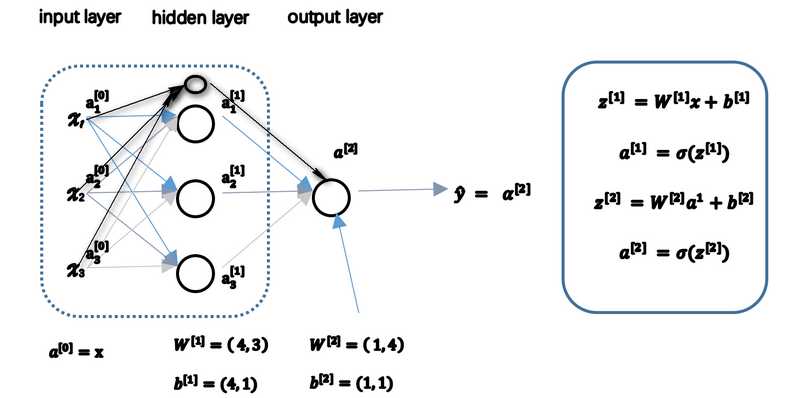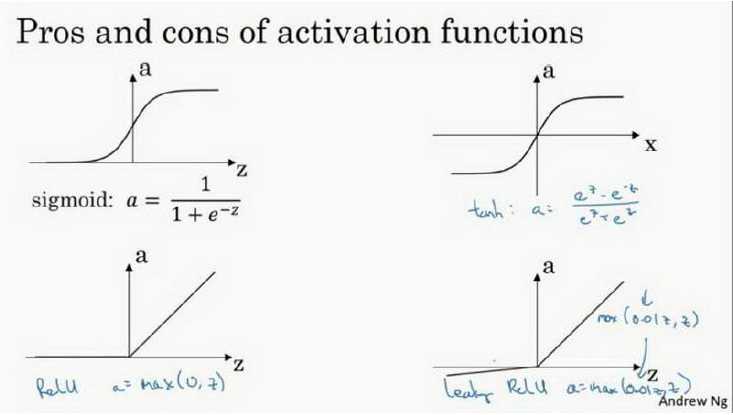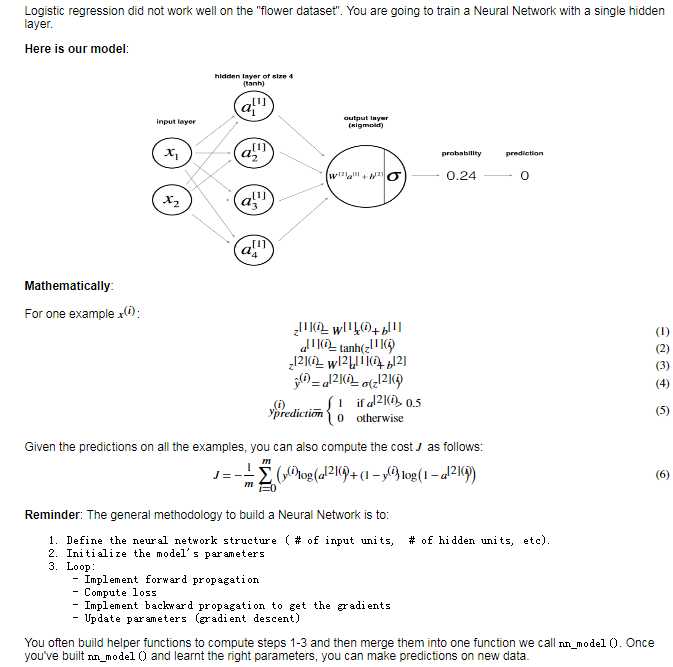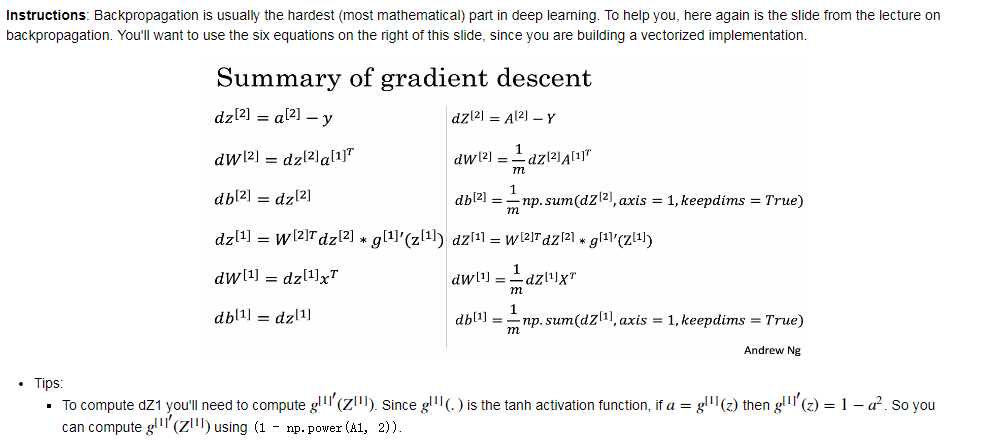淺層神經網絡
阿新 • • 發佈:2018-11-21
slide print sig bsp alt upd ive ret respond
1、神經網絡概述:



dW[L]=(1/m)*dZ[L]A[L-1].T
db[L]=(1/m)*np.sum(dZ[L],axis=1,keepdims=True)
dZ[L-1]=W[L].T dZ[L]*g‘(Z[L-1])
2. 激活函數:
sigmoid(z)=1/(1+e-z), tanh(z)=(ez+e-z)/(ez-e-z) , RelU(z)=max(0,z) , Leaky RelU(z)=max(0.01z,z)
sigmoid(z)‘=a(1-a), tanh(z)‘=1-a2 , RelU(z)‘=1 or 0 , Leaky RelU(z)‘=1 or 0.01

sigmoid激活函數:除了輸出層是一個二分類問題基本不會用它;
tanh激活函數:tanh是非常優秀的,幾乎適合所有場合;
ReLu激活函數:最常用的默認函數,如果不確定用哪個激活函數,就使用ReLu或者Leaky ReLu;
3.隨機初始化:
W[L]=np.random.randn(nL,nL-1)*0.01
bL=np.zeros((nL,1)
4.編程實踐:



1 #Defining the neural network structure: 2 def layer_sizes(X, Y): 3 """ 4 Arguments:5 X -- input dataset of shape (input size, number of examples) 6 Y -- labels of shape (output size, number of examples) 7 8 Returns: 9 n_x -- the size of the input layer 10 n_h -- the size of the hidden layer 11 n_y -- the size of the output layer 12 """ 13n_x = X.shape[0] # size of input layer 14 n_h = 4 15 n_y =X.shape[0] # size of output layer 16 17 return (n_x, n_h, n_y) 18 19 #Initialize the model‘s parameters 20 def initialize_parameters(n_x, n_h, n_y): 21 """ 22 Argument: 23 n_x -- size of the input layer 24 n_h -- size of the hidden layer 25 n_y -- size of the output layer 26 27 Returns: 28 params -- python dictionary containing your parameters: 29 W1 -- weight matrix of shape (n_h, n_x) 30 b1 -- bias vector of shape (n_h, 1) 31 W2 -- weight matrix of shape (n_y, n_h) 32 b2 -- bias vector of shape (n_y, 1) 33 """ 34 35 np.random.seed(2) # we set up a seed so that your output matches ours although the initialization is random. 36 37 ### START CODE HERE ### (≈ 4 lines of code) 38 W1 = np.random.randn(n_h,n_x)*0.01 39 b1 = np.zeros((n_h,1)) 40 W2 = np.random.randn(n_y,n_h)*0.01 41 b2 = np.zeros((n_y,0)) 42 43 ### END CODE HERE ### 44 45 assert (W1.shape == (n_h, n_x)) 46 assert (b1.shape == (n_h, 1)) 47 assert (W2.shape == (n_y, n_h)) 48 assert (b2.shape == (n_y, 1)) 49 50 parameters = {"W1": W1, 51 "b1": b1, 52 "W2": W2, 53 "b2": b2} 54 55 return parameters 56 57 #Implement forward_propagation() 58 def forward_propagation(X, parameters): 59 """ 60 Argument: 61 X -- input data of size (n_x, m) 62 parameters -- python dictionary containing your parameters (output of initialization function) 63 64 Returns: 65 A2 -- The sigmoid output of the second activation 66 cache -- a dictionary containing "Z1", "A1", "Z2" and "A2" 67 """ 68 # Retrieve each parameter from the dictionary "parameters" 69 ### START CODE HERE ### (≈ 4 lines of code) 70 W1 = parameters[‘W1‘] 71 b1 = parameters[‘b1‘] 72 W2 = parameters[‘W2‘] 73 b2 = parameters[‘b2‘] 74 ### END CODE HERE ### 75 76 # Implement Forward Propagation to calculate A2 (probabilities) 77 ### START CODE HERE ### (≈ 4 lines of code) 78 Z1 = np.dot(W1,X)+b1 79 A1 = np.tanh(Z1) 80 Z2 = np.dot(W2,A1)+b2 81 A2 = sigmoid(Z2) 82 ### END CODE HERE ### 83 84 assert(A2.shape == (1, X.shape[1])) 85 86 cache = {"Z1": Z1, 87 "A1": A1, 88 "Z2": Z2, 89 "A2": A2} 90 91 return A2, cache 92 93 #implement compute_cost 94 def compute_cost(A2, Y, parameters): 95 """ 96 Computes the cross-entropy cost given in equation (13) 97 98 Arguments: 99 A2 -- The sigmoid output of the second activation, of shape (1, number of examples) 100 Y -- "true" labels vector of shape (1, number of examples) 101 parameters -- python dictionary containing your parameters W1, b1, W2 and b2 102 103 Returns: 104 cost -- cross-entropy cost given equation (13) 105 """ 106 107 m = Y.shape[1] # number of example 108 109 # Compute the cross-entropy cost 110 ### START CODE HERE ### (≈ 2 lines of code) 111 logprobs = np.multiply(np.log(A2),Y)+np.multiply((1-Y),np.log((1-A2))) 112 cost =np.sum(logprobs)/m 113 ### END CODE HERE ### 114 115 cost = np.squeeze(cost) # makes sure cost is the dimension we expect. 116 # E.g., turns [[17]] into 17 117 assert(isinstance(cost, float)) 118 119 return cost 120 121 #implement backward_propagation: 122 def backward_propagation(parameters, cache, X, Y): 123 """ 124 Implement the backward propagation using the instructions above. 125 126 Arguments: 127 parameters -- python dictionary containing our parameters 128 cache -- a dictionary containing "Z1", "A1", "Z2" and "A2". 129 X -- input data of shape (2, number of examples) 130 Y -- "true" labels vector of shape (1, number of examples) 131 132 Returns: 133 grads -- python dictionary containing your gradients with respect to different parameters 134 """ 135 m = X.shape[1] 136 137 # First, retrieve W1 and W2 from the dictionary "parameters". 138 ### START CODE HERE ### (≈ 2 lines of code) 139 W1 = parameters[‘W1‘] 140 W2 = parameters[‘W2‘] 141 ### END CODE HERE ### 142 143 # Retrieve also A1 and A2 from dictionary "cache". 144 ### START CODE HERE ### (≈ 2 lines of code) 145 A1 = cache[‘A1‘] 146 A2 = cache[‘A2‘] 147 ### END CODE HERE ### 148 149 # Backward propagation: calculate dW1, db1, dW2, db2. 150 ### START CODE HERE ### (≈ 6 lines of code, corresponding to 6 equations on slide above) 151 dZ2 = A2-Y 152 dW2 = (1.0/m)*np.dot(dZ2,A1.T) 153 db2 = (1.0/m)*np.sum(dZ2,axis=1,keepdims=True) 154 dZ1 = np.multiply(np.dot(W2.T,dZ2),(1-np.power(A1,2))) 155 dW1 = (1.0/m)*np.dot(dZ1,X.T) 156 db1 = (1.0/m)*np.sum(dZ1,axis=1,keepdims=True) 157 ### END CODE HERE ### 158 159 grads = {"dW1": dW1, 160 "db1": db1, 161 "dW2": dW2, 162 "db2": db2} 163 164 return grads 165 166 #update_parameters: 167 def update_parameters(parameters, grads, learning_rate = 1.2): 168 """ 169 Updates parameters using the gradient descent update rule given above 170 171 Arguments: 172 parameters -- python dictionary containing your parameters 173 grads -- python dictionary containing your gradients 174 175 Returns: 176 parameters -- python dictionary containing your updated parameters 177 """ 178 # Retrieve each parameter from the dictionary "parameters" 179 ### START CODE HERE ### (≈ 4 lines of code) 180 W1 = parameters[‘W1‘] 181 b1 = parameters[‘b1‘] 182 W2 = parameters[‘W2‘] 183 b2 = parameters[‘b2‘] 184 ### END CODE HERE ### 185 186 # Retrieve each gradient from the dictionary "grads" 187 ### START CODE HERE ### (≈ 4 lines of code) 188 dW1 = grads[‘dW1‘] 189 db1 = grads[‘db1‘] 190 dW2 = grads[‘dW2‘] 191 db2 = grads[‘db2‘] 192 ## END CODE HERE ### 193 194 # Update rule for each parameter 195 ### START CODE HERE ### (≈ 4 lines of code) 196 W1 = W1-learning_rate*dW1 197 b1 = b1-learning_rate*db1 198 W2 = W2-learning_rate*dW2 199 b2 = b2-learning_rate*db2 200 ### END CODE HERE ### 201 202 parameters = {"W1": W1, 203 "b1": b1, 204 "W2": W2, 205 "b2": b2} 206 207 return parameters 208 209 #Build your neural network model 210 def nn_model(X, Y, n_h, num_iterations = 10000, print_cost=False): 211 """ 212 Arguments: 213 X -- dataset of shape (2, number of examples) 214 Y -- labels of shape (1, number of examples) 215 n_h -- size of the hidden layer 216 num_iterations -- Number of iterations in gradient descent loop 217 print_cost -- if True, print the cost every 1000 iterations 218 219 Returns: 220 parameters -- parameters learnt by the model. They can then be used to predict. 221 """ 222 223 np.random.seed(3) 224 n_x = layer_sizes(X, Y)[0] 225 n_y = layer_sizes(X, Y)[2] 226 227 # Initialize parameters, then retrieve W1, b1, W2, b2. Inputs: "n_x, n_h, n_y". Outputs = "W1, b1, W2, b2, parameters". 228 ### START CODE HERE ### (≈ 5 lines of code) 229 parameters = initialize_parameters(n_x,n_h,n_y) 230 W1 = parameters[‘W1‘] 231 b1 = parameters[‘b1‘] 232 W2 = parameters[‘W2‘] 233 b2 = parameters[‘b2‘] 234 ### END CODE HERE ### 235 236 # Loop (gradient descent) 237 238 for i in range(0, num_iterations): 239 240 ### START CODE HERE ### (≈ 4 lines of code) 241 # Forward propagation. Inputs: "X, parameters". Outputs: "A2, cache". 242 A2, cache = forward_propagation(X,parameters) 243 244 # Cost function. Inputs: "A2, Y, parameters". Outputs: "cost". 245 cost =compute_cost(A2,Y,parameters) 246 247 # Backpropagation. Inputs: "parameters, cache, X, Y". Outputs: "grads". 248 grads =backward_propagation(parameters,cache,X,Y) 249 250 # Gradient descent parameter update. Inputs: "parameters, grads". Outputs: "parameters". 251 parameters = update_parameters(parameters,grads) 252 253 ### END CODE HERE ### 254 255 # Print the cost every 1000 iterations 256 if print_cost and i % 1000 == 0: 257 print ("Cost after iteration %i: %f" %(i, cost)) 258 259 return parameters 260 261 #Use your model to predict by building predict().Use forward propagation to predict results 262 263 def predict(parameters, X): 264 """ 265 Using the learned parameters, predicts a class for each example in X 266 267 Arguments: 268 parameters -- python dictionary containing your parameters 269 X -- input data of size (n_x, m) 270 271 Returns 272 predictions -- vector of predictions of our model (red: 0 / blue: 1) 273 """ 274 275 # Computes probabilities using forward propagation, and classifies to 0/1 using 0.5 as the threshold. 276 ### START CODE HERE ### (≈ 2 lines of code) 277 A2, cache = forward_propagation(X,parameters) 278 predictions =np.where(A2>0.5,1,0) 279 ### END CODE HERE ### 280 281 return predictions
淺層神經網絡
